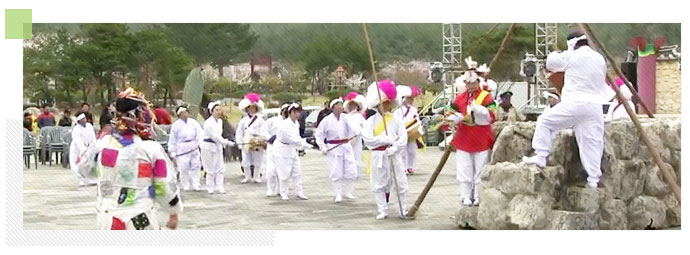
History
"Jeongdong Jeonghoje" is a traditional folk play handed down through the generations in Jeongdong village of Sinhak-ri, Sijong-myeon, Yeongam County. A sacrificial ritual is performed at the big well spring of the village at the dawn of the 15th day of January of the lunar calendar. This folk ritual is performed in the hopes of preventing disasters and to express wishes for a bountiful harvest and a large catch of fish. It consists of Jinpurigut, Dangsangut, and, after the ritual, Saemgut. Then comes Daedong Hanmadang in which men and women mingle in harmony. The songs are composed of five episodes including Sulbaesori, sung while making straw ropes, and Danggeumsori, sung while cleaning the spring.
Jeongdong was originally called 'Saemmol.' It was founded more than 1,000 years ago as a half-farming and half-fishing village. At the entrance of the village is Changjinpo. Ferry boats plying to and from Mokpo, or ships traveling in the offing of Sinan were moored here. The port flourished during the Japanese occupation of Korea.
According to Mr. Choi Yeongho, a resident of the Jeongdong village, men and women of all ages took part in the "Jeonghoje" (a.k.a. 'Wumulje', the 'well ritual') and performed Saemje starting with Dangsangut. The spring water was used for Pungeoje. At night torches were used to light up the premisses. Gut Garak (rhythm) includes 6 Saemgut Garak, 7 Dangsangut, and 8 Madanggut. Gutnori involved visiting every house from January 14 to early February to perform Jisinbapgi. What is noteworthy about Saemje is the Chukmun (memorial address), in which Confucianism, Buddhism and Zen are all combined.
On Yudu Day (June 15) a ritual for agricultural gods is performed as well.
Jeongdong was originally called 'Saemmol.' It was founded more than 1,000 years ago as a half-farming and half-fishing village. At the entrance of the village is Changjinpo. Ferry boats plying to and from Mokpo, or ships traveling in the offing of Sinan were moored here. The port flourished during the Japanese occupation of Korea.
According to Mr. Choi Yeongho, a resident of the Jeongdong village, men and women of all ages took part in the "Jeonghoje" (a.k.a. 'Wumulje', the 'well ritual') and performed Saemje starting with Dangsangut. The spring water was used for Pungeoje. At night torches were used to light up the premisses. Gut Garak (rhythm) includes 6 Saemgut Garak, 7 Dangsangut, and 8 Madanggut. Gutnori involved visiting every house from January 14 to early February to perform Jisinbapgi. What is noteworthy about Saemje is the Chukmun (memorial address), in which Confucianism, Buddhism and Zen are all combined.
On Yudu Day (June 15) a ritual for agricultural gods is performed as well.
Composition and sequence
First Madang : Jinpurigut
- Before entering Dangsan (shrine), Euljajin, Obangjin, Taegeukjin and Jinpuri Gut is performed, and then people enter Dangsan while performing Gilgut. All Gut's start with a Jinpuri.
Second Madang : Dangsangut
- In Dangsangut a sacrificial ritual is performed ahead of other sequences.
Third Madang : Saemgut
- People make straw ropes to set up the Jaksubal, and draw out all the water from the previous year. They then set the table and perform the sacrificial rite. They then hang a straw festoon before performing Saemgut.
Fourth Madang : Daedong Hanmadang
- Men and women of all ages mingle and harmonize as one in high spirits.
